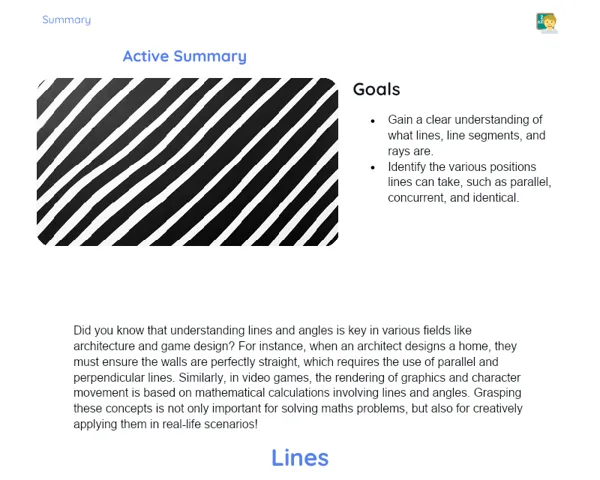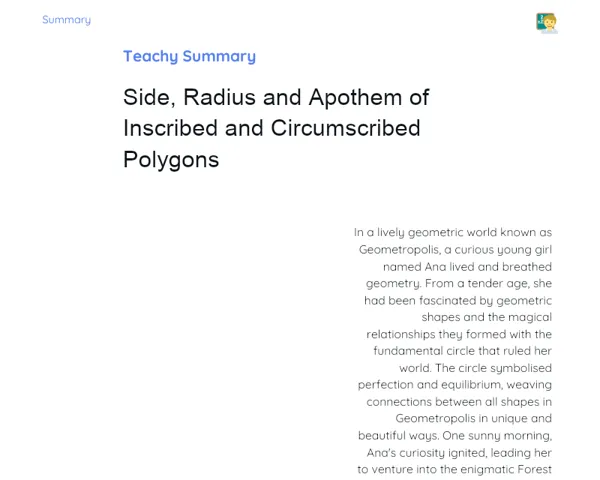Summary Tradisional | Trigonometry: Product-to-Sum Transformation
Contextualization
Trigonometry is a branch of mathematics that examines the relationships between the angles and sides of triangles. It plays a pivotal role in various fields such as engineering, physics, astronomy, and computer graphics. The Sum-to-Product Formulas, in particular, are essential tools developed to simplify intricate trigonometric calculations. These formulas enable the transformation of products of trigonometric functions, like sines and cosines, into more manageable sums or differences, which is particularly beneficial in scenarios involving multiple trigonometric functions, allowing for easier and more precise calculations.
Historically, before calculators and computers became common, the Sum-to-Product Formulas were vital for various applications. For instance, maritime navigators relied on these formulas for determining their routes and positions at sea, streamlining the requisite calculations for navigation. Today, these formulas are still relevant, both in academic settings and practical applications, such as in the field of computer graphics for creating lifelike animations and visual effects. Hence, grasping and applying the Sum-to-Product Formulas is critical for any student looking to deepen their understanding of trigonometry and its real-world uses.
To Remember!
Introduction to Sum-to-Product Formulas
The Sum-to-Product Formulas are mathematical tools that transform products of trigonometric functions into sums or differences, making it easier to handle complex trigonometric calculations. These formulas emerged from a necessity to simplify mathematical operations before the era of electronic calculators and were widely used in maritime navigation and other fields that demand precision and efficiency.
The core idea behind the Sum-to-Product Formulas is converting products of sines and cosines into sums. For instance, the product of two sines can be rewritten as a difference of cosines, while the product of two cosines can turn into a sum of cosines. This transformation aids in resolving trigonometric equations and integrating trigonometric functions.
Beyond their historical context, these formulas remain pertinent in modern areas such as computer graphics, where they help simplify the computations involved in geometric transformations. Understanding these formulas enables students to tackle trigonometric problems more effectively and lay a strong foundation for more advanced studies in mathematics and its applications.
-
Transform products of trigonometric functions into sums or differences.
-
Facilitate the simplification of complex trigonometric calculations.
-
Have historical applications in maritime navigation and modern uses in computer graphics.
Basic Sum-to-Product Formulas
The Sum-to-Product Formulas encompass three fundamental transformations: the product of sines, the product of cosines, and the product of sine and cosine. Each formula serves a specific purpose and helps simplify different types of trigonometric products.
The formula for the product of sines is: ( \sin(A) \sin(B) = \frac{1}{2} \left[ \cos(A - B) - \cos(A + B) \right] ). This rearranges the product of two sines into a difference of cosines, which is useful for simplifying expressions with multiple sines.
For the product of cosines, the formula is: ( \cos(A) \cos(B) = \frac{1}{2} \left[ \cos(A - B) + \cos(A + B) \right] ). Here, the product of cosines becomes a sum of cosines, frequently used in problems involving several cosines.
Lastly, the product of sine and cosine is given by: ( \sin(A) \cos(B) = \frac{1}{2} \left[ \sin(A + B) + \sin(A - B) \right] ). This formulation turns a product of sine and cosine into a sum of sines, useful when dealing with combinations of these functions.
-
Product of sines: ( \sin(A) \sin(B) = \frac{1}{2} \left[ \cos(A - B) - \cos(A + B) \right] ).
-
Product of cosines: ( \cos(A) \cos(B) = \frac{1}{2} \left[ \cos(A - B) + \cos(A + B) \right] ).
-
Product of sine and cosine: ( \sin(A) \cos(B) = \frac{1}{2} \left[ \sin(A + B) + \sin(A - B) \right] ).
Practical Application Examples
To gain a clearer understanding of how the Sum-to-Product Formulas are applied, let's examine some practical examples illustrating the simplification of products of trigonometric functions.
Example 1: Simplifying ( \sin(30º) \sin(45º) ). Using the sine product formula, we have: ( \sin(30º) \sin(45º) = \frac{1}{2} [ \cos(30º - 45º) - \cos(30º + 45º) ] ). This further simplifies to ( \frac{1}{2} [ \cos(-15º) - \cos(75º) ] ).
Example 2: Simplifying ( \cos(60º) \cos(30º) ). Using the cosine product formula, we get: ( \cos(60º) \cos(30º) = \frac{1}{2} [ \cos(60º - 30º) + \cos(60º + 30º) ] ). This results in ( \frac{1}{2} [ \cos(30º) + \cos(90º) ] ).
Example 3: Simplifying ( \sin(45º) \cos(60º) ). Following the sine and cosine product formula: ( \sin(45º) \cos(60º) = \frac{1}{2} [ \sin(45º + 60º) + \sin(45º - 60º) ] ), we arrive at ( \frac{1}{2} [ \sin(105º) + \sin(-15º) ] ).
-
Example 1: ( \sin(30º) \sin(45º) ).
-
Example 2: ( \cos(60º) \cos(30º) ).
-
Example 3: ( \sin(45º) \cos(60º) ).
Applications in Complex Problems
The Sum-to-Product Formulas prove valuable in resolving more intricate trigonometric problems, such as proving trigonometric identities and integrating trigonometric functions. These applications showcase the adaptability and usefulness of these formulas in advanced mathematical contexts.
For instance, consider the identity ( \sin(x) \sin(2x) = \frac{1}{2} \left[ \cos(x) - \cos(3x) \right] ). By applying the sine product formula, we find: ( \sin(x) \sin(2x) = \frac{1}{2} [ \cos(x - 2x) - \cos(x + 2x) ] ), simplifying to ( \frac{1}{2} [ \cos(-x) - \cos(3x) ] ) or ( \frac{1}{2} [ \cos(x) - \cos(3x) ] ).
Another scenario involves integrating trigonometric functions. Take the integral ( \int \sin(3x) \cos(4x) , dx ). Applying the sine and cosine formula results in ( \frac{1}{2} \int [ \sin(7x) + \sin(-x) ] , dx ), which can be integrated easily.
These examples highlight how the Sum-to-Product Formulas can be deployed to effectively tackle complex problems, emphasizing the significance of mastering these formulas for advancement in trigonometry and related areas of mathematics.
-
Proving trigonometric identities using Sum-to-Product.
-
Utilization in integrals of trigonometric functions.
-
Importance for efficiently solving complex problems.
Key Terms
-
Trigonometry: Study of relationships between angles and sides of triangles.
-
Sum-to-Product Formulas: Formulas that convert products of trigonometric functions into sums or differences.
-
Product of Sines: ( \sin(A) \sin(B) = \frac{1}{2} [ \cos(A - B) - \cos(A + B) ] ).
-
Product of Cosines: ( \cos(A) \cos(B) = \frac{1}{2} [ \cos(A - B) + \cos(A + B) ] ).
-
Product of Sine and Cosine: ( \sin(A) \cos(B) = \frac{1}{2} [ \sin(A + B) + \sin(A - B) ] ).
-
Expression Simplification: The process of streamlining a mathematical expression for easier manipulation.
-
Trigonometric Identities: Equations that hold true for all possible values of the involved variables.
-
Integration of Trigonometric Functions: The method of calculating the integral of functions involving sines and cosines.
Important Conclusions
In this lesson, we explored the Sum-to-Product Formulas, which serve as vital mathematical tools for converting products of trigonometric functions into sums or differences. We understood how these formulas can simplify intricate calculations and assist in resolving trigonometric problems. We reviewed three main formulas: the product of sines, the product of cosines, and the product of sine and cosine, and we saw practical scenarios on applying them.
Additionally, we delved into the application of these formulas in tackling more complex issues, like proving trigonometric identities and integrating trigonometric functions. These applications reveal the versatility of the Sum-to-Product Formulas and their significance in advanced mathematics, engineering, physics, and beyond.
We reiterated the importance of the knowledge acquired, stressing that mastering these formulas can alleviate complex calculations and enhance problem-solving in diverse practical situations. We encourage students to continue their exploration of this topic and expand their studies in trigonometry and its applications.
Study Tips
-
Practice problem-solving using the Sum-to-Product Formulas to reinforce understanding and confidence in applying these concepts.
-
Review other related trigonometric topics, including identities and integrals of trigonometric functions, to see how the Sum-to-Product Formulas integrate into the broader field of trigonometry.
-
Utilise additional resources such as textbooks, educational videos, and online exercises to discover various approaches and real-life applications of the Sum-to-Product Formulas.



